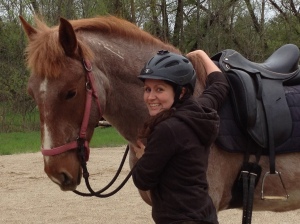I’ve had numerous conversations lately about how to structure a good training session. While the initial mechanical skills of training are fairly simple to learn or be coached through, the larger picture of structuring a session is more complex. In The Little Book of Talent, by Daniel Coyle, he discusses hard skills versus soft skills. Hard skills or “high precision skills are actions that are performed as correctly and consistently as possible, every time.” In horse training, hard skills would be: click/treat order, treat hand remaining still between dispensing rewards, skilled rope and rein handling, and consistent and intentional body language on the ground and in the saddle. Hard skills can and should be learned from a live coach, if possible. They are finite and very measurable; they form the foundation of your skill set as a trainer.
But, as you master your hard skills and move from working your horse in lessons to teaching him by yourself, you will need to have more soft skills so you can create useful training sessions for your horse. Soft skills are about flexibility, recognizing and creating patterns, breaking patterns when necessary, reading situations and adjusting accordingly. Soft skills are both what guide you in making a training plan and help you change that training plan in the moment so your horse can be successful. Soft skills are harder to learn because they are very subjective to the individual horse and learning situation. Keeping notes about each training session, being aware and responsive to your horse’s body language during training and videotaping yourself while your train for review later are all practices that will help you develop your own soft skills. They take time. So where to begin if you are just getting started?
Kay Laurence, a talented dog trainer who runs “learning about dogs” differentiates between a teaching session and a training session. A teaching session is a short session where the entire time is devoted to teaching the horse one new behavior. You will still be shaping or using successive approximations, but your focus will be on teaching your learner just one behavior or motor pattern. Teaching sessions are necessary and, in the early stages of training, make up a majority of your sessions. Think of your teaching sessions as installing the foundation or component skills of your horse’s program. You will use these components in more complex sessions later.
Training sessions are focused practice where you will work on multiple behaviors in one session, usually toward a larger unified goal. Initially, you should work on moving smoothly between repetitions of your component skills. Even very advanced training sessions are made up of component skills, they’ve just been layered skillfully together. If your horse knows two foundation behaviors, you could do five repetitions of the first behavior and then five repetitions of the second behavior, clicking and treating for each repetition. The larger goal is just to teach your horse emotional flexibility in moving between different skills and to teach yourself how to gracefully transition between multiple subjects in one lesson. Make sure you can do this simpler training exercise before biting off something more complex. If you aren’t sure what component skills your horse should have, a coach or trainer can help you identify and teach those individual pieces.
Below, I have video of Aesop, my 2007 BLM mustang gelding in a more layered training session preparing him for riding. I’ve listed the component skills we utilized so you can watch for them as they come up. All of these are behaviors I will click and reinforce:
- bend to the inside from a balanced slide down the rein
- go forward from slight touch on your side (my ribcage)
- bring your shoulders toward me from an opening slide down the inside rein
- move your shoulders over and away from me from a lift on the inside rein
- maintain your line once started unless another cue is give (duration)
- stand on a mat
- offer bend when standing still
- target poll to fingers when raised above head
- trot on a verbal cue
Combined together, these component skills add up to a horse who understands the cues needed to be responsive under saddle. He knows how to respond in multiple ways to the rein, how to use my body as a target, how to stop and stand quietly and how to offer the beginnings of softness. He’s ready to be ridden. In part two, I will explain and detail how to set up a training session to transfer these cues to a novel situation – riding!









